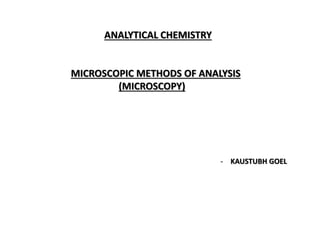Report
Share

Recommended
Recommended
More Related Content
What's hot
What's hot (20)
Cathodoluminescence for Gallium Nitride Semiconductor Materials

Cathodoluminescence for Gallium Nitride Semiconductor Materials
Application of non destructive test for structural health monitoring - state ...

Application of non destructive test for structural health monitoring - state ...
Similar to ANALYTICAL CHEM_MICROSCOPY
Similar to ANALYTICAL CHEM_MICROSCOPY (20)
4.1.1 microscopy - Class 9 - Textbook of Biology - FBISE Islamabad 

4.1.1 microscopy - Class 9 - Textbook of Biology - FBISE Islamabad
ANALYTICAL CHEM_MICROSCOPY
- 1. ANALYTICAL CHEMISTRY MICROSCOPIC METHODS OF ANALYSIS (MICROSCOPY) - KAUSTUBH GOEL
- 2. MICROSCOPY AS A MODERN TECHNOLOGY: It is a technical science that deals with the development of microscope techniques to view and study the properties of the material not visible by naked eyes. This is a very modern science that is developed to understand the variety of different materials through variety of microscopic analysis. It is very necessary in our today’s scientific study to know about the compounds, molecules that are present in the materials , objects , substances under consideration. We have to understand the structure and molecular arrangements to know about the properties and behavior of that material. In the study of such properties, microscopy leads the field of technology to know better about the compounds. Using microscopy, one can magnify the objects upto 1500x than the original size. Example: Optical Microscope.
- 4. OPTICAL MICROSCOPE TYPICAL ELECTRON MICROSCOPE MODERN SCANNING ELECTRON MICROSCOPE
- 5. MODERN ATOMIC FORCE MICROSCOPE (AFM) SCANNING TUNNELING MICROSCOPE (STM)
- 6. WORKING PROCEDURE OF SCANNING TUNNELING MICROSCOPE: A voltage bias is applied and the tip is brought close to the sample by coarse sample-to-tip control, which is turned off when the tip and sample are sufficiently close. At close range, fine control of the tip in all three dimensions when near the sample is typically piezoelectric, maintaining tip-sample separation W typically in the 4-7 Å (0.4-0.7 nm) range, which is the equilibrium position between attractive (3< W < 10Å) and repulsive (W < 3Å) interactions. In this situation, the voltage bias will cause electrons to tunnel between the tip and sample, creating a current that can be measured. Once tunneling is established, the tip's bias and position with respect to the sample can be varied and data are obtained from the resulting changes in current. T.E.
- 7. WORKING PROCEDURE OF ATOMIC FORCE MICROSCOPE: As the cantilever is displaced along the sample surface so does the direction of the laser beam reflection changes along the surface of the photodiode resulting into the image formation with the help of detector and feedback electrical equipments.
- 8. A T.E.M. IMAGE OF POLIO VIRUS OF 30 NM IN SIZE. A S.T.M. IMAGE OF GOLD(100). A S.T.M. IMAGE OF SiC SURFACE. MAGNIFIED IMAGE OF POLLENS USING S.E.M.
- 9. A CBP officer of Field Operations Department checking the authenticity of a travel document using the optical microscope at an International Airport.
- 10. ADVANTAGES AND USEFULNESS OF MICROSCOPY: Microscopy has many types of microscopic devices for various purposes; due to which we can have the desired resolution of the object we want to magnify and view. Furthermore it’s precision and sharpness is to a such high extent which is of the order of Nano meter(10-9m) or much higher. Better resolutions mean better images and greater understanding and Microscopy is a total advantage for such things. Utility is diverse with Microscopy. Every type of microscope has a special use to produce a high resolution image of a particular material. The research and development in field of Biology has a very important and notable usage of Microscopes which has always been fascinating and wonderful. Example: Development of Cell Theory is totally based on Microscopic Methods. Also in other fields like Chemistry and Physics Microscopy holds a very important use. Example: Semiconductors; Neurology ; etc.
- 11. FIELDS OF APPLICATIONS OF MICROSCOPY: • There are variety of applications of this technique based on the type of Microscope used. • All modern fields and fields like Life Sciences and Physics make most of the use of Microscopy. • Fields like Nanotechnology, Nanochemistry , Nanophysics , Semiconductors , Neuroscience, physiology etc. make use of this technique. • In areas of non scientific approach also, we can see a very useful application of Microscopy like International Airports, Megamalls, Universities etc. • Thus Microscopy has a very useful advantage of making things highly magnified to view better and understand the objects in a very smart way.
- 12. Nature is beautiful and things are like objects of Nature…Keep understanding…